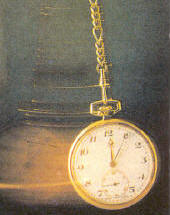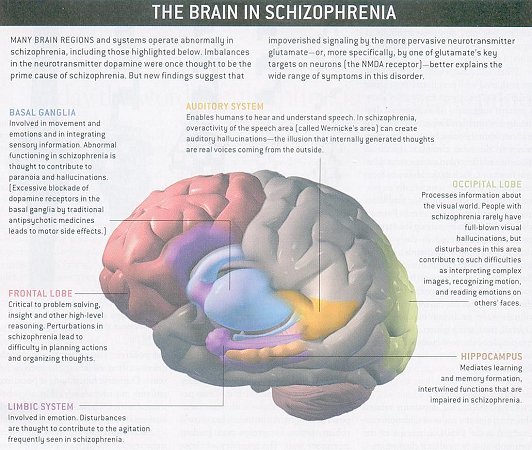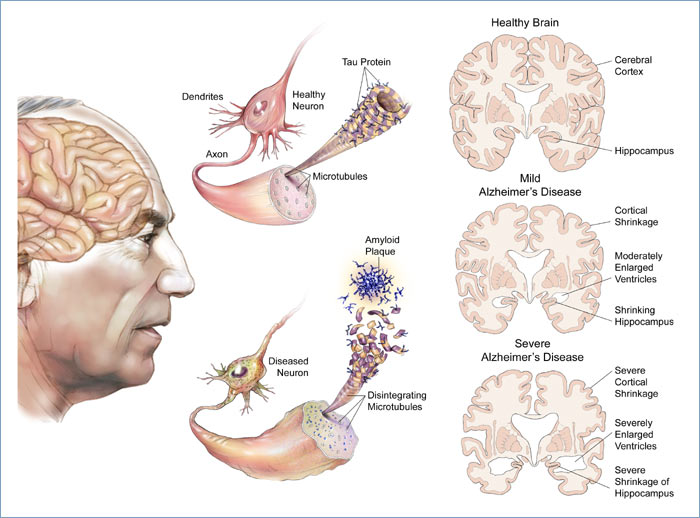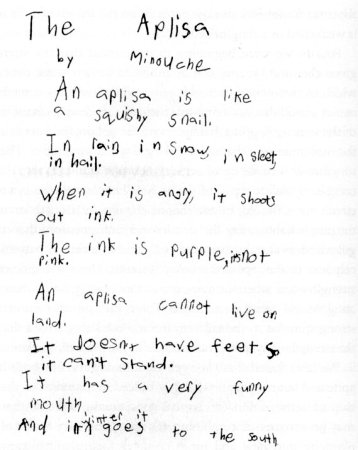Contents
Neurons and Nerves
Neurotransmitter
The Brain
Spinal Cord
Peripheral Nervous System
Autonomic Nervous System
Senses:
Sight,
Senses,
Smell,
Taste,
Senses,
Senses
Memory
Higher Functions
Altered States
[Top]
 | Hypnosis - Modern studies show that the brain waves of hypnotized subjects are much like those of the waking state. When subjects are hypnotized, they can speak, walk and carry out instructions. Yet there are some noticeable changes from normal consciousness: attention becomes very selective, with the subject ignoring everything but the hypnotist's voice; the subject rarely initiates thought or activity, but waits for suggestions from the hypnotist; and fantastic ideas or situations are more readily accepted as reality. It is almost as if the willing, relaxed subject relinquishes control over part of his or her consciousness to the hypnotist. The classic method of hypnotism is to put a subject into a relaxed frame of mind and ask him or her to concentrate on an object, such as a swinging pocket watch (Figure 37). Brain scans (Figure 33) show increased activity during hypnosis in the motor and sensory | | areas suggesting heightened mental imagery. Increased blood flow in the right anterior cingulate cortex suggests that attention is focused on internal events. The brain activity seen in this state is quite different from that seen in normal waking or sleeping. |
 | Sexual fantasy - This is the ability to use our imaginations erotically. It is found that people spend a surprising amount of time thinking about sex. There are vast cultural differences in what different societies consider acceptable material for sexual fantasy and fetishes. The Victorians considered fetish to be shocking and dangerous, the true dark side of sexuality; while the Freudian view treats fetishism as the result of linking unresolved childhood drives to object that seems "safe" such as the high-heeled shoe. Many therapists now consider that it is perfectly normal to have sexual fantasies, and some even believe that they can be used to achieve a more fulfilling sex life. Research into sexual fantasies is complicated and must rely on what patients report to their therapists, but some studies have found links with childhood events - either sexual violence or a strict, repressed upbringing. There is an obvious distinction between fantasy and action - a fantasy does not harm others. However, some people who have | | fantasies that involves inflicting pain to themselves or others (such as to the cat in Figure 38) claim that they feel compelled to act them out. Sometimes people with less extreme fantasies also choose to turn them into realities such as in the form of cross dressing. |
 | Addiction - Drug addiction is caused by a similar train of events to hunger. However, unlike most types of food, addictive drugs cause changes in the receptors to which they bind, making them less sensitive. This creates tolerance and addiction. Most addictive drugs work by altering levels of neurotransmitters in the brain's reward circuitry centered on the limbic areas. Other brain areas are also involved and each type of drug works in a slightly different way to produce its characteristic effects. Opiates are drugs derived from the dried resin of the opium poppy (Figure 39), or synthetic versions of these chemicals, such as heroin, codeine and morphine. All | | have been used medicinally at some time for their pain-killing properties. They are used illegally for similar reasons: heroin gives the user a "high", reducing anxiety and producing a sense of temporary well-being. |
Schizophrenia (shattered mind) - There is evidence to suggest that genetic vulnerability and environmental stressors can act in combination to cause schizophrenia. Some researchers estimate schizophrenia to be highly heritable. But a recent review of the genetic evidence has suggested only a 28% chance of one identical twin developing schizophrenia if the other already has it. A recent study listed seven genes as likely to be involved in the inheritance of schizophrenia or the risk of developing the disease. One of these genes known as COMT is involved in encoding the dopamine catabolic enzyme. This is interesting because of the known link between dopamine function, psychosis, and schizophrenia. There is considerable evidence indicating that stressful life events cause or trigger schizophrenia psychosis. Childhood experiences of abuse or trauma have also been implicated as risk factors for a diagnosis of schizophrenia later in life. There is also consistent evidence that negative attitudes towards individuals with schizophrenia can have a significant adverse impact. In particular, critical comments, hostility, and intrusive or controlling attitudes from family members have been found to correlate with a higher risk of relapse in schizophrenia across cultures. Factors such as poverty and discrimination also appear to be involved in increasing the risk of schizophrenia or  | schizophrenia relapse, perhaps due to the high levels of stress they engender. The disease is frequently accompanied by paranoia and delusions. Some may experience extremely bizarre hallucinations. Ironically, while some areas of the schizophrenic brain may be dead, in other ways the sufferer's brain is overactive. Most schizophrenics appear to have an excess of dopamine in the brain, the neurons become overloaded and relay inappropriate messages (see Figure 40 for a modern view). Lack of activity in the frontal lobes is a feature of states of mind in which consciousness is disturbed. This might account for the state's common reduction in planned or spontaneous behavior and social withdrawal. The anterior cingulate cortex - thought to distinguish between external and internal stimuli - is also underactive (Figure 33), which may be one reason schizophrenics confuse their own thoughts with outside voices. |
| Recently in 2006, it is found that those with mutations in the PCM1 gene had a significantly lower volume of grey matter in their orbitofrontal cortex resulting in poor judgement, inappropriate social behaviour and not keeping themselves clean. PCM1 plays a role in cell division, which in the brain occurs more actively at adolescence - an age at which schizophrenia is commonly diagnosed. |
Dementia - Dementia is used to describe the organic deterioration of the brain that affects the elderly. The main, but not sole, form of dementia is Alzheimer's disease, and 25 percent of people who live to be older than 85 will show some symptoms. One of the hallmarks of Alzheimer's disease is the accumulation of amyloid plaques between neurons in the brain. Amyloid is a general term for protein fragments that the body produces normally. In a healthy brain, these protein fragments would be broken down and eliminated. In Alzheimer's disease, the fragments accumulate to form hard, insoluble plaques (see Figure 41). Neurofibrillary tangles consist of insoluble twisted fibers that are found inside of the brain's cells. They primarily consist of a protein called tau, which forms part of a structure called a microtubule. The microtubule helps transport nutrients and other important substances from one part of the nerve cell to another. In Alzheimer's disease the tau protein is abnormal and the microtubule structures collapse (see Figure 41). There is an overall shrinkage of brain tissue as Alzheimer's disease progresses. In addition, the ventricles are noticeably enlarged. In the early stages of Alzheimer's disease, short-term memory begins to decline when the cells in the hippocampus, degenerate (see Figure 41). The ability to perform routine tasks also  |
declines. As Alzheimer's disease spreads through the cerebral
cortex, judgment declines, emotional outbursts may occur and
language is impaired. Progression of the disease leads to the death
of more nerve cells and subsequent behavior changes, such as
wandering and agitation. The ability to recognize faces and to
communicate is completely lost in the final stages. Patients lose
bowel and bladder control, and eventually need constant care. This
stage of complete dependency may last for years before the patient
dies. The average length of time from diagnosis to death is 4 to 8
years, although it can take 20 years or more for the disease to run
its course. | | |
Vision - It is virtually impossible to carry out research into
visions in the laboratory, because they do not happen on demand; as
a result, the only evidence that visions do exist is the accounts of
those people who have experienced them. Vision may occur in response
to stress. They are often central to religious experience.
Out-of-body experiences are not restricted to religious practices:
they seem to occur in response to some kind of emergency situation.
This is the case with near-death  |
experiences. There have been thousands of reports of near-death
experiences, many noting the same types of sensations. Subjects
feel as though they have left their bodies. Some people report
travelling down a tunnel toward a bright light (Figure 42),
where benevolent presences wait. Scientists have been unable to
explain them conclusively. Some physiologists have suggested
that hypoxia, or low oxygen levels in the brain, might cause a
consistent pattern of hallucination in all sufferers. Other
scientists argue | |
that the experience stems from an acute bout of "REM
intrusion" into the partially awakening state (in time of
extreme stress) similar to narcolepsy - a neurological
disorder characterised by uncontrollable bouts of sleep that
can cause elaborate hallucinations and, sometimes,
out-of-body experiences. |
¶The
challenge of finding an ideal model animal in which a physical basis
of memory formation might be revealed was taken up in the 1960s byE.
R. Kandel, who eventually received the Nobel Prize in Physiology
or Medicine in 2000 for his efforts on investigating the nervous
system with Aplysia. The Aplysia did not share the prize, but his
daughter Minouche at the age of seven has written a poem to enshrine
the animal:
 |
An aplisa is like a squishy snail.
In rain, in snow, in
sleet, in hail.
When it is angry, it shoots out ink.
The
ink is purple, it's not pink.
An aplisa cannot live on land.
It doesn't have feet so it can't stand.
It has a very funny
mouth.
And in winter it goes to the south.
| | |
Go to the nervous system
|